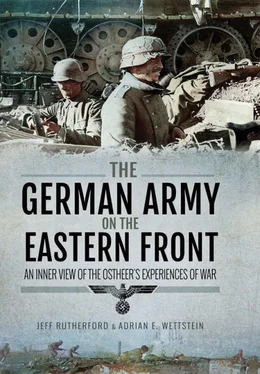The light infantry gun monitored the western part of the village and the hills behind the village and could effectively fire on the enemy fleeing from the village.
Feldwebel Oertel, who with his armoured car was receiving fire from 6 enemy machine guns on the main street, forced the enemy to yield and, while doing so, had 3 tyres destroyed and the rims penetrated by armour piercing rounds.
By 1930 hrs the situation was as follows:
The motorcycle groups had combed through the eastern part, while the armoured cars had already broken the main resistance of the enemy in the western part of the village. Meanwhile dusk was so advanced, that Leutnant Sassenberg decided to withdraw all units of the operation and to take up a position of all-around defence in Ozenowka and wait for new orders from the battalion, since the purpose of the attack – to throw back the enemy and to inflict losses – had full success with extremely low losses on our side.
Statements of that battalion’s prisoners, who were taken the next day at a different place in the sector, confirmed that the enemy had left behind numerous wounded and dead men.
The operation again was executed by Leutnant Sassenberg in a calm, objective-focused and rousing manner. Our losses: 1 wounded.
This battle highlighted the most important facets of German tactical thinking and practice: speed, surprise, initiative on all levels, decisiveness, aggressiveness, combined arms action, the combination of manoeuvre and fire, flanking and leadership by example. Those terms applied to German tactics throughout the war. [2]But the way those words were carried out in practice did evolve over the course of the conflict. This was a consequence of the many challenges that arose in the eastern theatre, most of which were not closely examined or thought about before the war due to the expectation of a short Blitzkrieg campaign. On the tactical level, these challenges included terrain and weather conditions not previously experienced in the war by German troops, such as extremely cold winter weather, high-altitude mountain warfare, fighting in the endless primeval forests of north-western Russia, and urban warfare. Adaptation was also needed against the Soviet opponent, which injected its own will, its own ideas and, in some areas, superior weapons and huge quantities of men and material into battle. While the minimal research that exists on the topic suggests that the Red Army was slower to adapt on the tactical level than the German army, what Williamson Murray termed ‘complex adaption’ fits for both armies in the process of learning and adapting on the Eastern front, since both were in constant development. [3]Furthermore, as the war went differently than planned, the Germans needed to (re-)learn tactical practices that had been neglected up until this time, such as positional or anti-tank warfare, as well as defensive warfare in general. Tactical developments were strongly influenced by issues discussed in other chapters, such as the often critical supply situation, the continual warfare on the Eastern front, and the enormous losses in leaders and soldiers. Therefore, the following chapter focusses more on the dynamics, dependencies and development in the tactical area than specifically on tactics. Since tactics are closely related to weapons and organization structures, these will also be discussed here.
The German army had a long tradition of achieving high levels of professionalism in this area, allowing it to successfully attack and defend against much more numerous enemies. While recent research has supported the thesis that this tactical excellence was achieved at the cost of sound strategic expertise, the sources of this tactical excellence still require more research. This is all the more astonishing, because even though the German army continually suffered high losses from mid-1941 on, it maintained a relatively formidable level of tactical professionalism until summer 1944, when the massive double defeats in Normandy and Belarus profoundly changed the character of the army.
In looking at explanations for this tactical superiority, flexible guidelines that not only allowed for a commander to decide on the spot the best way to fulfil his mission, but actually demanded it, combined with a thoroughly trained and educated officer and NCO corps, were clearly important factors, as seen in chapter 2. Skilled, battle-oriented training by combat-experienced officers and NCOs, as well as further training behind the front for men and leaders, was another essential basic. This will be more closely examined in chapter 6. Finally, and what will be discussed here, is the impact of rapid learning. Experiences over long periods of time were distilled, learned, and applied by German units and their leaders much more quickly than by their opponents.
At the base of the learning process lay the will to learn and improve, and to do so in a systematic manner. The foundation of this practice could be found in the Napoleonic era and in the formation of the General Staff, but a massive impulse came after the Franco-Prussian War. [4]So the German army in the east had a well-established reporting system, which included special experience reports. On certain occasions, such reports were ordered by superior commands. In the following source, Sixth Army ordered such a set of reports by its subordinated units after the end of the German summer offensive 1942: [5]
In the near future, a specially commissioned officer of the 6th Army staff will be sent to the corps commands and to individual divisions for the purpose of compiling combat experiences of this year’s summer campaign. Written experience reports are to be supplemented and deepened through personal debriefings.
The divisional and corps staffs now need to take a position on the following questions and prepare their oral answers:
1) Battle in the steppe (all corps): advance, attack, transition to the defence.
2) Special features of the battle in the Stalingrad fortress (only LIst Army Corps): Attack preparations, attack, deployment on the main battlefield located in the urban area.
3) Defence of massed tank attacks (only XIVth Panzer Corps).
4) The layout of, entrenchment and combat in this year’s winter positions (without LIst Army Corps).
Points of view frame how experiences are written down:
A) Experiences of the leadership
B) Tactical combat experiences
C) Weapon technology experiences
D) Other experiences
The required reports covered issues new for the German army (such as fighting on the steppe), but also issues that were understood as becoming increasingly important (such as urban warfare or defence against massed tank attacks, both of which had already occurred in 1941 and early 1942, but were previously viewed as being the exception). The corps mentioned in the order did pass the demand for experience reports to their subordinate divisions (i.e. LIst Army Corps ordered 24th Panzer Division to report about urban warfare), and the divisions collected information from their organic and temporarily subordinated units. These analyses were then summarized into a final report and, together with selected reports of lower levels, sent back to the corps. The corps normally added its own observations, sometimes offering a contradicting view, to the division’s report, or it compiled reports from several divisions. In the best case, this went back to the army’s central institutions in Germany. What made the German system so effective, however, was that this was not a one-way network. Divisions and corps did not simply wait for regulations coming back from central institutions, i.e. official leaflets or even manuals, but immediately used their collected experiences, ordering changes in tactics, unit structure, weapons use, command style and training. [6]A closer look at the German army in the east reveals that it was in permanent evolution. This frequently included trial and error, as war is no exact science. Not all variations proved successful, and many lessons learned could not be implemented due to a lack of men and material.
Читать дальше






![John Stieber - Against the Odds - Survival on the Russian Front 1944-1945 [2nd Edition]](/books/405234/john-stieber-against-the-odds-survival-on-the-russian-front-1944-1945-2nd-edition-thumb.webp)





